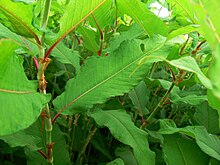| Koenigia polystachya | |
|---|---|

| |
| Scientific classification | |
| Kingdom: | Plantae |
| Clade: | Tracheophytes |
| Clade: | Angiosperms |
| Clade: | Eudicots |
| Order: | Caryophyllales |
| Family: | Polygonaceae |
| Genus: | Koenigia |
| Species: | K. polystachya |
| Binomial name | |
| Koenigia polystachya (Wall. ex Meisn.) T.M.Schust. & Reveal | |
| Synonyms | |
| |
Koenigia polystachya is a species of flowering plant in the knotweed family, known by the common names Himalayan knotweed and cultivated knotweed. It has several regularly used synonyms, including Polygonum polystachyum, Aconogonon polystachyum and Persicaria wallichii.
Koenigia polystachya is native to Asia (southwestern China, Indian Subcontinent, Myanmar, Afghanistan) and it is planted many places as an ornamental. It has the capacity to become an invasive species and has established itself in some parts of North America, primarily the Pacific Coast of the United States and Canada. It is an invasive weed in the mountains of Sri Lanka.
Koenigia polystachya is a rhizomatous perennial herb producing thick, hollow, erect stems easily exceeding one meter (40 inches) in length. Via its rhizomes it can form dense colonies. It may also spread asexually if sections of the stem containing rooting nodes are separated and moved to a new area; chopping the plant into small pieces does not necessarily keep it from growing. The hairy leaves are up to 20 centimeters (8 inches) long. The branching inflorescence is an array of lacy clusters of many small white flowers.
Called thothnay in Sikkim and Darjeeling areas of India, the pleasantly sour-tasting edible shoots and stems are used as vegetable or used to make piquant condiments and accompaniments for meals.
References
- ^ "Koenigia polystachya (Wall. ex Meisn.) T.M.Schust. & Reveal". Plants of the World Online. Royal Botanic Gardens, Kew. Retrieved 2019-02-24.
- Washington State Noxious Weeds
- Biota of North America Program 2014 county distribution map
- ^ Flora of China, Polygonum polystachyum Wallich ex Meisner in Wallich, 1832. 多穗神血宁 duo sui shen xue ning
- Lalith Gunasekera, "Himalayan Plant Invading Beautiful Nuwara Eliya", Sri Lanka Guardian, 13.10.2011, Accessed 19.6.2016.
- CDFA EncycloWeedia
External links
| Taxon identifiers | |
|---|---|
| Persicaria wallichii |
|
This Polygonaceae article is a stub. You can help Misplaced Pages by expanding it. |